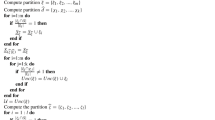Abstract
The huge size of multimedia data requires for efficient data classification and organization in providing effective multimedia data manipulation. Those valuable data must be captured and stored for potential purposes. One of the main problems in Multimedia Information System (MIS) is the management of multimedia data. As a consequence, multimedia data management has emerged as an important research area for querying, retrieving, inserting and updating of these vast multimedia data. This research considers the rough set theory technique to organize and categorize the multimedia data. Rough set theory method is useful for exploring multimedia data and simplicity to construct multimedia data classification. Classification will help to improve the performance of multimedia data retrieving and organizing process.
Access this chapter
Tax calculation will be finalised at checkout
Purchases are for personal use only
Preview
Unable to display preview. Download preview PDF.
Similar content being viewed by others
References
Nordin, M.A.R., Farham, M., Suhailan, S., Sufian, M.D., Kamir, M.Y.: Applying Time Granularity in Multimedia Data Management. In: Proc. International Conference on Computational Intelligence and Vehicular System (CIVS), pp. 60–64 (2010)
Pawlak, Z., Grzymala–Busse, J.W., Slowiriski, R., Ziarko, W.: Rough Sets. Comm. of the ACM. 38(11), 88–95 (1995)
Pawlak, Z.: Rough Set: Theoretical Aspects of Reasoning About Data. Kluwer Academic Publishers, Dordrent (1991)
Zhong, N., Dong, J.Z., Ohsuga, S.: Using Rough Sets with Heuristics for feature Selection. Journal of Intelligent Information Systems 16, 199–214 (2001)
Shyng, J.-Y., Wang, F.-K., Tzeng, G.-H., Wu, K.-S.: Rough Set Theory in Analyzing the Attributes of Combination Values for the Insurance Market. Journal of Expert Systems with Application 32, 56–64 (2007)
Jalal, S.K.: Mutimedia Database: Content and Structure. In: Workshop on Multimedia and Internet Technologies, Bangalore (2001)
Griffioen, J., Seales, B., Yavatkar, R., Kiernan, K.S.: Content Based Multimedia Data Management and Efficient Remote Access. Extrait de la Revue Informatique et Statistique dens les Sciences Humaines 1(4), 213–233 (1997)
Candan, K.S., Sapino, M.L.: Data Management for Multimedia Retrieval. Cambridge University Press, New York (2010)
Cheong, S.N., Azahar, K.M., Hanmandlu, M.: Development of Web-based Multimedia News Management System for News on Demand Kiosk Network. WSEAS Transaction on Computers 2(2), 360–365 (2003)
Azhar, R., Zhao, X., Cone, S., Merrell, R.: Electronic Multimedia Data Management for Remote Population in Ecuador. International Congress Series 1268, 301–306 (2004)
Abidin, S.Z.Z., Idris, N.M., Husain, A.H.: Extraction and Classification of Unstructured Data in WebPages for Structured Multimedia Database via XML. In: International Conference in Information Retrieval Knowledge Management (CAMP), pp. 44–49 (2010)
Xu, W.-H., Zhang, W.-X.: Knowledge Reduction in Consistent Information System Based on Dominance Relations. In: Liu, Y., Chen, G., Ying, M. (eds.) Optimization Techniques 1973. LNCS, vol. 3, pp. 1493–1496. Springer, Tsinghua University Press (2006)
Wang, Y., Ding, M., Zhou, C., Zhang, T.: A Hybrid Method for Relevance Feedback in Image Retrieval Using Rough Sets and Neural Networks. International Journal of Computational Cognition 3(1), 78–87 (2005)
Fomina, M., Kulikov, A., Vagin, V.: The Development of The Generalization Algorithm based on The Rough Set Theory. International Journal Information Theories & Application 13(13), 255–262 (2006)
Hu, X.: Using Rough Sets Theory and Database Operation to Construct a Good Ensemble of Classifiers for Data Mining Applications. In: Proc. of ICDM, pp. 233–240 (2001)
Nordin, M.A.R., Yazid, M.M.S., Aziz, A., Osman, A.M.T.: DNA Sequence Database Classification and Reduction: Rough Sets Theory Approach. In: Proc. of 2nd International Conference on Informatics, pp. 41–47 (2007)
Author information
Authors and Affiliations
Editor information
Editors and Affiliations
Rights and permissions
Copyright information
© 2011 Springer-Verlag Berlin Heidelberg
About this paper
Cite this paper
Rahman, M.N.A., Lazim, Y.M., Mohamed, F., Safei, S., Deris, S.M., Yusof, M.K. (2011). Rough Set Theory Approach for Classifying Multimedia Data. In: Zain, J.M., Wan Mohd, W.M.b., El-Qawasmeh, E. (eds) Software Engineering and Computer Systems. ICSECS 2011. Communications in Computer and Information Science, vol 180. Springer, Berlin, Heidelberg. https://doi.org/10.1007/978-3-642-22191-0_10
Download citation
DOI: https://doi.org/10.1007/978-3-642-22191-0_10
Publisher Name: Springer, Berlin, Heidelberg
Print ISBN: 978-3-642-22190-3
Online ISBN: 978-3-642-22191-0
eBook Packages: Computer ScienceComputer Science (R0)




